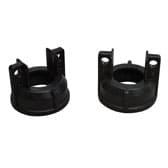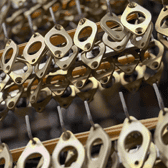Passivation
Passivation is a chemical finishing process that utilizes nitric or citric acid to dissolve ferrous contaminants on a metal surface. Iron can otherwise cause corrosion, so by immersing a component in a chemical solution and removing any free iron present on its surface, passivation generates an oxide layer overtop the metal. This decreases the likelihood that there will be a chemical reaction between the metallic material and the air, which lends the surface protection against corrosion without changing its appearance. At New Method Plating Company, Inc., our team will work with you to achieve a customized finish for your application to optimize performance.
What Is the Purpose of Passivation?
The primary goal of passivation is to provide that thin, uniform oxide layer to add corrosion resistance to metal components. As rust can develop when iron is present, the removal of ferrous particles from a surface helps safeguard against rust formation.
Passivation is important for preventing surface contamination. Manufacturing processes like machining, fabricating, and welding create debris, inclusions, metal oxides, and other contaminants on a metal part’s surface, and passivation removes those particles. As a result, the process has the added benefit of minimizing the risk that any surface particles might contaminate a product.
The passivation process can also aid your operation in reducing overall downtime. Producing the passive oxide layer on metal components for added corrosion protection and durability can increase the life span of your equipment, meaning it will typically require less repair and replacement over time. The overall process leads to increased production safety and lower maintenance costs, regardless of the industry.
What Are Some Examples of Passivation?
A range of industries capitalizes on components that manufacturers have finished with passivation treatments for added durability and longevity.
- Medical. In the healthcare sector, professionals use passivation to decrease harmful cross-contamination on medical equipment. The oxide layer on passive surfaces safeguards against microscopic contaminants, leading to a clean and smooth surface that’s easier to sterilize.
- Food and beverage. Many industries must meet specific sanitary requirements. By passivating components, there is a lower risk of corrosion and rust compromising equipment or handled final products. In some industries, such as the food and beverage industry, passivation is done after installation, but before food processing or preparation staff first use the equipment to ensure that it is fully contaminant-free to work with consumable goods.
Passivation With New Method Plating Company, Inc.
A family-owned and -operated company since 1931, New Method Plating Company specializes in precision electroplating and metal finishing services. We strive to enhance the functionality of your product as well as the aesthetics. In addition to passivation and electroplating, our services include sandblasting, degreasing, and chem film coating. Our team works with metals like cadmium, chrome, copper, nickel, and zinc to provide added versatility in our capabilities for clients in the defense, military, aerospace, and communication sectors, among others.
We take pride in our superior craftsmanship, with a team that is strongly committed to quality and safety. As an ISO 9001:2015-certified and NADCAP-accredited finishing service provider, we also comply with the aerospace industry’s standards for passivation: ASTM A967, AMS 2700, and AMS QQ-P-35. New Method Plating Company also believes in innovation, and we have upgraded our equipment and our Worcester, Massachusetts, facility as part of our goal of achieving excellence in our field of metal finishing and specialty plating. We utilize robotics and other advanced, automated equipment for high degrees of consistency and precision.
For more information on passivation or our capabilities, contact us today or request a quote to begin your project.





